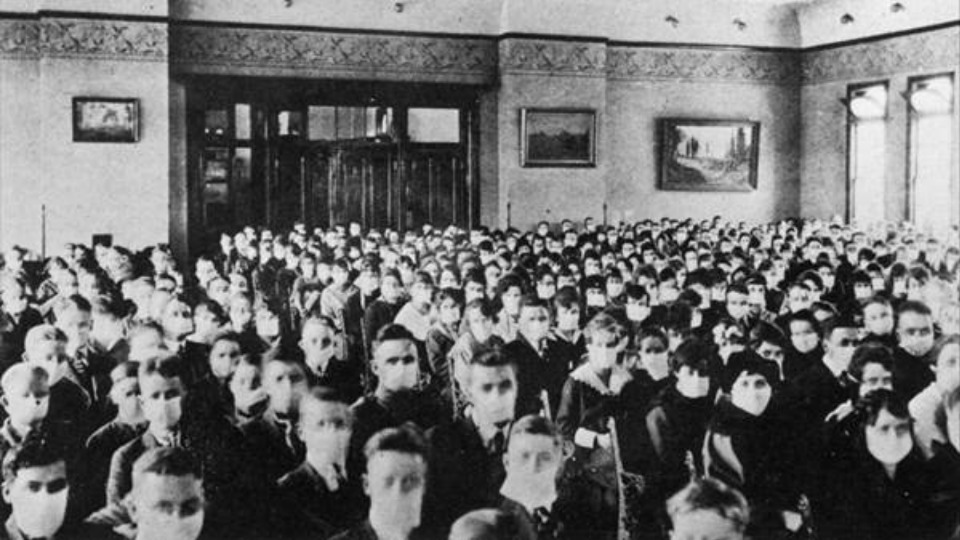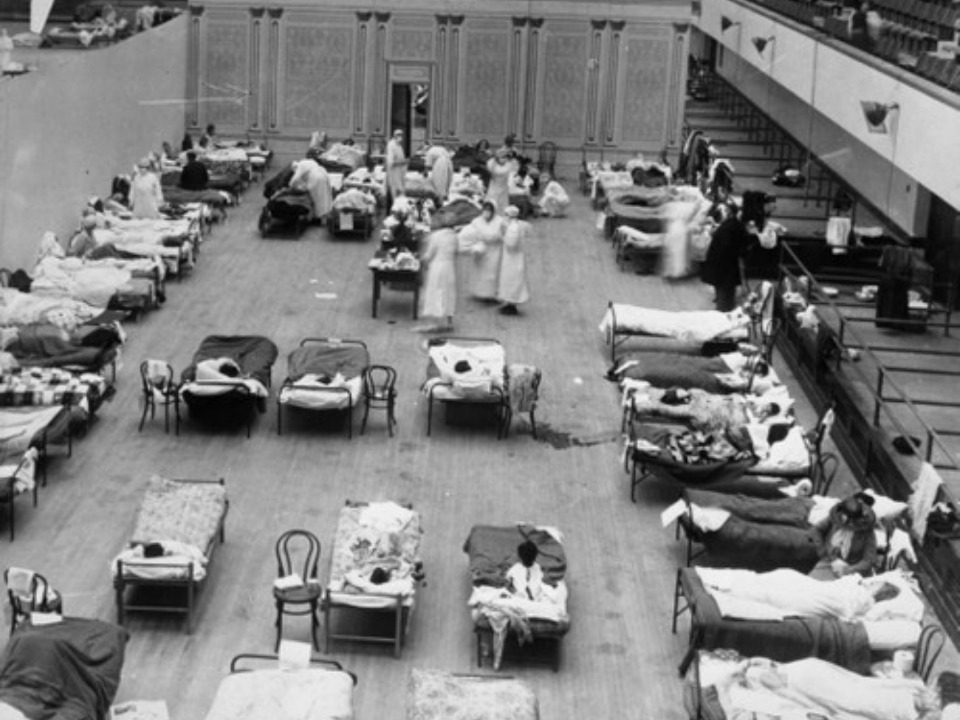
Epidemics
Students wearing hygienic masks in an effort to prevent the spread of the influenza virus gather in College Hall at Brigham Young University in January of 1919, during what was known as the Spanish flu pandemic. Courtesy of Church News.All rights reserved.This story appears here courtesy of TheChurchNews.com. It is not for use by other media.
By Sarah Jane Weaver, Church News
Dating back to the earliest days of The Church of Jesus Christ of Latter-day Saints, members have dealt with illness, disease and pandemics, said historian Richard E. Turley Jr.
The former assistant Church historian and managing director of the Church’s Public Affairs Department said early Latter-day Saints did all they could to prevent or cure disease.
“One of the things that we’re learning about the COVID-19 disease is that there are some simple things that can be done, and I find it fascinating that the examples of the past show Church leaders who are sacrificing often their own convenience, and in some cases, their own health, in order to assist others,” he said.
As COVID-19 cases began to surge across the globe and the First Presidency urged members to use face masks and be vaccinated, Turley spoke to the Church News about the lessons of the past. “History, like all subjects, has very little value unless it’s applied in a way that does some good,” he said.
He shared an overview of how early and modern Church leaders have responded to past pandemics:
- Between 1811 and 1814, the Joseph Smith Sr. and Lucy Mack Smith family faced a major typhoid outbreak that affected the community along the Connecticut River Valley where they were living, Turley said. “All seven of the Smith children caught it,” he said. “Joseph [Jr.] had a particularly severe case of it. He ended up with an affliction of his legs, what we call today osteomyelitis. His parents did everything they could to save their children.” Joseph underwent an experimental surgery that saved his leg and his life.
- In March 1832, when Joseph and Emma Smith’s adopted twins contacted measles, Joseph and Emma were doing everything they could to care for those measles-stricken twins, “when a mob burst into the house, dragged out Joseph, stripped him of his clothing, severely beat him and covered him in tar and feathers.” A few days later, their twin son died of complications of measles, perhaps exacerbated by the stress of that attack.
- In the late 1820s, a cholera pandemic swept the earth. The first issue of the Church’s newspaper, the Evening and Morning Star, devoted a substantial amount of space to the pandemic. “Church printer William W. Phelps declared: ‘If ever the pestilence walked in darkness or destruction wasted at noonday, now is the time,’” said Turley. “In a subsequent issue, he declared: ‘Not since the flood, if we think right, has the Lord sent the same pestilence or destruction over the whole earth at once, but the cholera gives a solemn token to a wondering world that it will do so.’” Turley said the disease would go on to ravage Church members for decades. During the Camp of Israel, also called Zion’s Camp, Joseph Smith and others were stricken by the disease and 13 participants in Zion’s Camp died.
- In 1839, as Joseph Smith and other early Latter-day Saints settled Nauvoo, they were stricken with malaria — a disease called by the Centers for Disease Control and Prevention “one of the most severe public health problems worldwide.” Turley said Joseph, and his wife, Emma, turned their log home into a hospital for those who were ill, risking their own health.
- In the late 1840s and much of the 1850s, cholera affected Church members, especially companies traveling to the Salt Lake Valley to join early Latter-day Saints. To reduce or prevent outbreaks, Church President Brigham Young wrote to “the leader supervising immigration and directed him to reroute companies away from New Orleans to Eastern ports, or have them travel during seasons of the year when cholera was not prevalent,” said Turley.
- During the flu pandemic of 1918 and 1919, the Church took steps to prevent the spread of disease, including canceling or altering meetings. The First Presidency directed families to take care of themselves where possible, freeing up Red Cross workers to help others. “Beginning earlier in 1912, Church leaders directed the changing from a common sacrament cup, which had been the tradition since the beginning of the Church, to individual sacrament cups, but local congregations had been somewhat slow in adhering to this direction. The flu pandemic accelerated that transition,” Turley said.

Epidemic
A temporary hospital was set up in the Oakland Municipal Auditorium in California during the 1918 flu epidemic.All rights reserved.
- Polio affected many during the mid-20th-century, including Boyd K. Packer, who later became President of the Quorum of the Twelve Apostles. He suffered the effects of the illness throughout his life. In 1956, the First Presidency issued a letter encouraging the vaccination of missionaries. In the last paragraph, President David O. McKay, President Steven L. Richards and President J. Reuben Clark wrote: “In recent years, we have had a number of tragic cases of polio in the missions, and we are confident that missionaries and their parents will see the wisdom of taking every precaution to avoid tragedies of this kind.”
- In 1976, as the swine flu was sweeping the world, the First Presidency issued another directive, encouraging Church members to carefully consider the potential benefits and risks of being vaccinated. In the final paragraph they wrote: “Because of the comprehensive nature of this immunization campaign and the great cost associated with it, volunteers are being sought in local areas to assist in carrying out the vaccination. Members of the Church who are technically qualified and who feel so inclined are encouraged to provide what community service they can to assist with this influenza immunization campaign.”
- In 1978, the First Presidency issued a directive that expressed concern that parents weren’t having their children immunized against childhood diseases. The First Presidency wrote: “Reports that increasing numbers of children are not being immunized against preventable childhood diseases is deeply concerning to us. … We urge members of The Church of Jesus Christ of Latter-day Saints to protect their own children through immunization.”
Concluding, Turley said, “History, like all subjects, has very little value unless it’s applied in a way that does some good, and I think that the survey I’ve done about the history of epidemics over time convinces me that the good we can do from this is to learn from history.”
Copyright 2021 Deseret News Publishing Company
